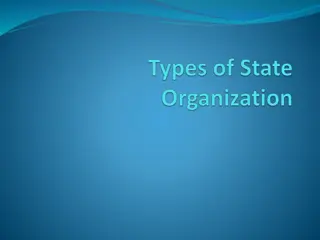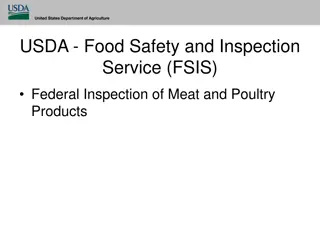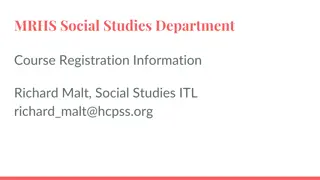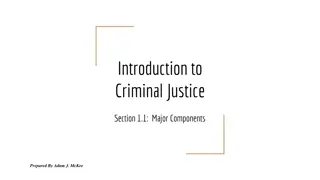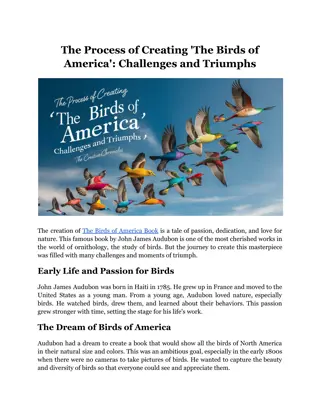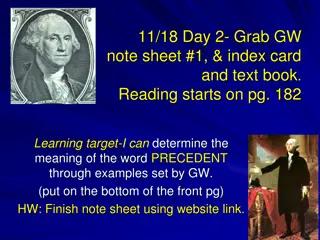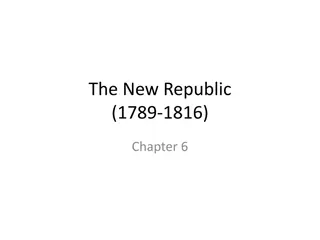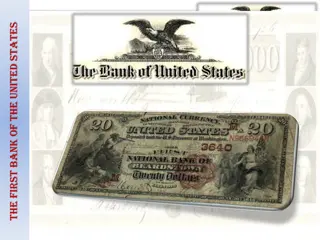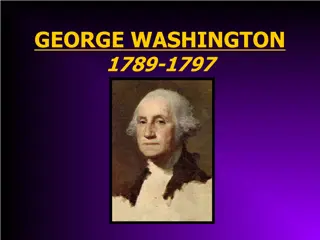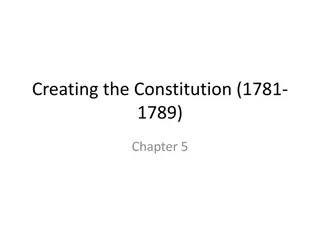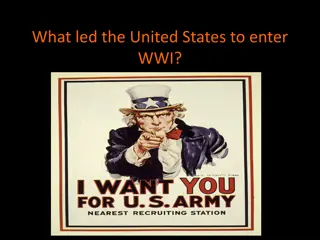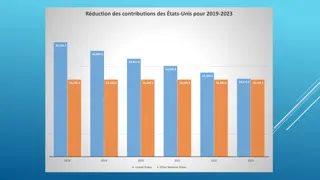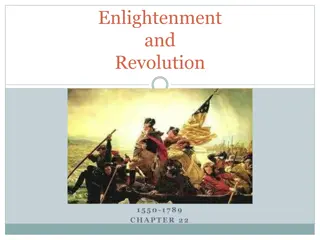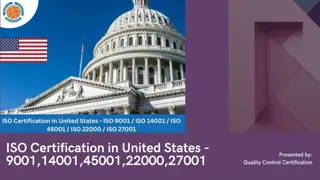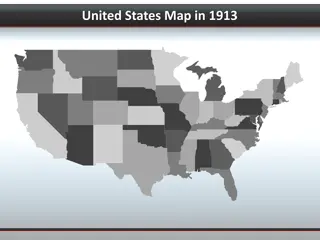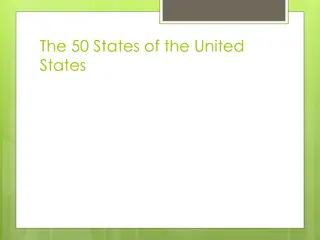Early Challenges and Triumphs of the United States in 1789
The year 1789 marked the birth of the New America with the launch of the U.S. Constitution. Challenges such as overwhelming debt, a rural population doubling every 20 years, and the formation of a diverse cabinet under the leadership of the imposing first President were overcome. The adoption of the Bill of Rights, the establishment of federal courts, and Alexander Hamilton’s influential economic plan were key milestones shaping the new nation's trajectory.
Download Presentation

Please find below an Image/Link to download the presentation.
The content on the website is provided AS IS for your information and personal use only. It may not be sold, licensed, or shared on other websites without obtaining consent from the author. Download presentation by click this link. If you encounter any issues during the download, it is possible that the publisher has removed the file from their server.
E N D
Presentation Transcript
Chapter 10 Launching the New Ship of State
The New America 1789 - New U.S. Constitution was launched Population was doubling every 20 years. 90% rural 5% living west of the Appalachians. Vermont became the 14th state in 1791 Kentucky, Tennessee, and Ohio (states where trans-Appalachian overflow was concentrated) became states soon after. Visitors looked down upon the crude, rough pioneers, and these western people were restive and dubiously loyal at best. America was also heavily in debt Paper money was worthless Monarchs watched to see if the U.S. could succeed in setting up a republic while facing such overwhelming odds
The 1stPresident Imposing Figure - 6 2 , 175 pounds, with broad and sloping shoulders, a strongly pointed chin and pockmarks from smallpox Unanimously elected president by the Electoral College in 1789. Journey from Mt. Vernon to New York (capital at the time) was a triumphant procession filled with cheering crowds and roaring festivities Took the oath of office on April 30, 1789, on a balcony overlooking Wall Street. Washington established a diverse cabinet (which was not necessary Constitutional). Secretary of State: Thomas Jefferson Secretary of the Treasury: Alexander Hamilton Secretary of War: Henry Knox
The Bill of Rights States ratified the Constitution on the condition that there would be a Bill of Rights adopted 1791 Amendment I: Freedom of religion, speech or press, assembly, and petition. Amendment II: Right to bear arms (for militia). Amendment III: Soldiers can t be housed in civilian homes during peacetime. Amendment IV: No unreasonable searches; all searches require warrants. Amendment V: Right to refuse to speak during a civil trial; No Double Jeopardy. Amendment VI: Right to a speedy and public trial. Amendment VII: Right to trial by jury when the sum exceeds $20. Amendment VIII: No excessive bails and/or fines. Amendment IX: Other rights not enumerated are also in effect. People s Rights Amendment X: Unlisted powers belong to the state. ( States Rights Amend)
Judiciary Act of 1789 Created effective federal courts John Jay became the first Chief Justice of the United States
Alexander Hamilton Born in the British West Indies Loyalty to the U.S. was often questioned Claimed he loved his adopted country more than his native country
Hamiltons Economic Plan He urged the federal government to pay its debts of $54 million and try to pay them off at face value ( Funding at Par ), plus interest, as well as assume the debts of the states of $21.5 million (this was known as "assumption"). Massachusetts had a huge debt, but Virginia didn t, so there needed to be some haggling. This was because Virginia felt it unfair that all debts were to be assumed by the entire nation. Essentially, its rival states would be at the same level as Virginia, even though they had obtained larger debts. The bargain: Virginia would have the District of Columbia built on its land (gaining prestige) in return for letting the government assume all the states debts. The Funding at Par would gain the support of the rich to the federal government, not to the states.
Custom Duties and Excise Tax The national debt at a huge $75 million, Alexander Hamilton was strangely unworried. He used the debt as an asset: the more people the government owed money to, the more people would care about what would happen to the U.S. as a whole nation. To pay off some of the debt, Hamilton the first custom duties, imposing a low tariff of about 8% of the value of dutiable imports Passed in 1789. Hamilton also wanted to protect America s infant industries, though the U.S. was still dominated by agricultural programs. Little was done regarding this. In 1791, Hamilton secured an excise tax on a few domestic items, notably whiskey (at 7 cents per gallon).
Battle Over a Bank Hamilton proposed a national treasury Private institution modeled after the Bank of England Federal government would be a major stockholder Circulate cash to stimulate businesses Store excess money Print money that was worth something Opposed by Jefferson as being unconstitutional (as well as a tool for the rich to better themselves).
Battle Over Interpretation Hamilton Jefferson What was not forbidden in the Constitution was permitted. A bank was necessary and proper (from Constitution). He evolved the Elastic Clause, AKA the necessary and proper clause, which would greatly expand federal power. This is a loose interpretation of the Constitution. What was not permitted was forbidden. A bank should be a state- controlled item (since the 10th Amendment says powers not delegated in the Constitution are left to the states). Constitution should be interpreted literally and through a strict interpretation.
And the Winner Is Hamilton won the dispute Washington reluctantly signed the bank measure into law The Bank of the United States was created by Congress in 1791, and was chartered for 20 years. It was located in Philadelphia and was to have a capital of $10 million. Stock was open to public sale bought out in 2 hours
Whiskey Rebellion 1794, western Pennsylvania farmers revolted against Hamilton s excise tax Around those parts, liquor and alcohol was often used as money. They said they d been unfairly singled out to be taxed. They cried taxation without representation since many were from Tennessee and Kentucky which were not yet states and had no one in Congress. Washington cautiously sent an army of about 13,000 troops from various states to the revolt, but the soldiers found nothing upon arrival; the rebels had scattered. Washington s new presidency now commanded new respect, but anti-federalists criticized the government s use of a sledgehammer to crush a gnat. The lesson of the Whiskey Rebellion: this government, unlike the Articles, was strong! IMPORTANCE: First real test of the new government.
The French Revolution Near the end of Washington s first term (1793) two parties had evolved: the Jeffersonian Democratic-Republicans and the Hamiltonian Federalists. The French Revolution greatly affected America. At first, people were overjoyed, since the first stages of the revolution were not unlike America s dethroning of Britain. When the French declared war on Austria, then threw back the Austrian armies and proclaimed itself a republic, Americans sang The Marseillaise and other French revolutionary songs, and renamed various streets and places. THEN - the revolution turned radical and bloody, the Federalists rapidly changed opinions and looked nervously at the Jeffersonians, who felt that no revolution could be carried out without a little bloodshed. Neither group completely approved of the French Revolution and its antics. America was sucked into the revolution when France declared war on Great Britain and the battle for North American land began again.
Washington Picks a Side Again With war came the call by the Democratic-Republicans to enter on the side of France, the recent friend of the U.S., against Britain, the recent enemy. Hamilton leaned toward siding with the Brits, as doing so would be economically advantageous. Washington knew that war could mean disaster and disintegration, since the nation in 1793 was militarily and economically weak and politically disunited. In 1793, he issued the Neutrality Proclamation, proclaiming the U.S. s official neutrality and warning Americans to stay out of the issue and be impartial. Jefferson s Democratic-Repulicans were furious, and this controversial statement irked both sides, France and England.
The Genet Affair Citizen Edmond Gen t, landed at Charleston, South Carolina, as a French representative to the U.S. Had been cheered by Jeffersonian D-Rs (supported France) so he thought that Washington s Neutrality Proclamation didn t truly reflect the feelings of Americans, he was wrong He equipped privateers to plunder British ships and to invade Spanish Florida and British Canada. He even threatened to appeal over the head of Washington to the voters. He was basically escorted out of the U.S. Actually, America s neutrality helped France, since it was the only way France could get American foodstuffs to the Caribbean islands. France was mad that the U.S. didn t help them officially.
Problems with Britain Britain still had many posts in the frontier, and supplied the Indians with weapons. The Treaty of Greenville, in 1795, had the Indians cede their vast tract in the Ohio country to the Americans after General Mad Anthony Wayne crushed them at the Battle of Fallen Timbers on August 20, 1794. Americans learned of the British supplying guns to the Indians Ignoring America s neutrality, British commanders of the Royal Navy seized about 300 American merchant ships and impressed (kidnapped) scores of seamen into their army. Many JDR s cried out for war with Britain, or at least an embargo, but Washington refused, knowing that such drastic action would destroy the Hamilton financial system.
Jays Treaty In a last-ditch attempt to avert war, Washington sent John Jay to England to work something out. Negotiations were sabotaged by England-loving Hamilton, who secretly gave the Brits the details of America s bargaining strategy The results of the Jay Treaty with England weren t pretty: Britain would repay lost money from recent merchant ship seizures called impressment , but said nothing about future seizures/supplying arms to Indians. America would have to pay off its pre-Revolutionary War debts to Britain. Result: the JDR s from the South were furious, as the southern farmers would have to pay while the northern merchants would be paid. Jay s effigy was burnt in the streets. However, war was avoided.
Pickneys Treaty At this time, the Pinckney Treaty of 1795 with Spain gave Americans free navigation of the Mississippi and the large disputed territory north of Florida. Oddly, it was the pro-British Jay Treaty that prompted Spain to be so lenient in the Pinckney Treaty (since Spain didn t want America buddying up to their enemy, England).
Washington Sets a Precedent After his second term, Washington stepped down, creating a strong two-term precedent that wasn t broken until FDR was president. His Farewell Address warned (1) against political parties and (2) against building permanent alliances with foreign nations. Washington had set the U.S. on its feet and had made it sturdy.
The 2ndPresident of the US Hamilton was the logical choice to become the next president, but his financial plan had made him very unpopular. John Adams, the ablest statesmen of his day, won, 71 to 68, against Thomas Jefferson, who became vice president. Adams had a hated rival and opponent in Hamilton, who plotted with Adams cabinet against the president, and a political rival in his vice president. He also had a volatile situation with France that could explode into war.
The XYZ Affair France was furious about the Jay s Treaty, calling it a flagrant violation of the 1778 Franco-American treaty, and so began seizing defenseless American merchant ships. In the XYZ Affair, John Adams sent three envoys (including John Marshall) to France, where they were approached by three agents, X, Y, and Z, who demanded a load of 32 million florins and a $250,000 bribe just for talking to Talleyrand. Even though bribes were routine in diplomacy, such a large sum for simply talking weren t worth it, and there was no guarantee of an agreement. The envoys returned to America, cheered by angry Americans as having done the right thing for America. Irate Americans called for war with France, but Adams, knowing that war could spell disaster, remained neutral. An undeclared war mostly confined to the seas raged for two and a half years, where American ships captured over 80 armed French ships.
Another French Meeting Talleyrand, knowing that war with the U.S. would add another enemy to France, declared that if another envoy was sent to France, that it would be received with respect. In 1800, the three American envoys were met by Napoleon (who had by then taken over in France), who was eager to work with the U.S. Treaty signed in Paris Ended the 1778 alliance Americans paid for the ships and goods they had stolen In keeping the U.S. at peace, John Adams plunged his popularity and lost his chance at a possible second term, but he did the right thing, keeping the U.S. neutral while it was still weak.
Alien and Sedition Acts Alien Laws - Federalists raised the residence requirements for aliens who wanted to become citizens from five to fourteen years Violated the traditional American policy of open-door hospitality and speedy assimilation Let the president deport dangerous aliens during peacetime and jail them during times of war. The Sedition Act - anyone who impeded the policies of the government or falsely defamed its officials, including the president, would be liable to a heavy fine and imprisonment Aimed at newspaper editors and the JDR s Obviously unconstitutional Passed by the Federalist majority in Congress Upheld in the court because of the majority of Federalists there too. Written to expire in 1801 to prevent the use of it against Federalists (in case they weren t re-elected) Matthew Lyon was one of those imprisoned when he was sentenced to four months in jail for writing ill things about President John Adams. Elections of 1798-99 - Federalists won the most sweeping victory of their history.
The Virginia (Madison) and Kentucky (Jefferson) Resolutions Jefferson feared that the Federalists, having wiped out freedom of speech and of the press, might wipe out more. Wrote a series of legislation that Kentucky approved in 1798-99, and James Madison wrote another series of legislation that Virginia approved. Compact theory - states made the federal government, the federal government makes laws, but since the states made the federal government, the states reserve the right to nullify federal laws. Theory goes by several names, all synonymous: the compact theory, states rights theory, or nullification. Legislation set out to kill the Sedition and Alien Laws. Only those two states adopted the laws. Federalists argued that the people, not the states, had made the contract, and it was up to the Supreme Court to nullify legislation. Neither Madison nor Jefferson wanted secession, they did want an end to Federalist abuses.
The First Political Parties By 1800 the country had broken into two very distinct political parties (despite Washington s warnings) Federalists (led by Hamilton) Democratic-Republicans (led by Jefferson)
Federalists Most were the old Federalists from before the Constitution Wanted a strong government ruled by the educated aristocrats, the best people Saw debt as a good thing Merchants, manufacturers, and shippers along the Atlantic seaboard Many were wealthy Mostly pro-British Recognized that foreign trade was key in the U.S
Democratic-Republicans Desired rule by informed classes and a weaker central government that would preserve the sovereignty of the states Mostly pro-French Emphasized that national debt had to be paid off Mostly agrarians (farmers), and insisted on no privileges for the upper class. They saw farming was ennobling: it kept people away from wickedness of the cities, in the sun, and close to God. Advocated rule of the people, but not all the people, just those who weren t ignorant Slavery could help avoid a class of landless voters by providing the necessary labor Championed free speech





